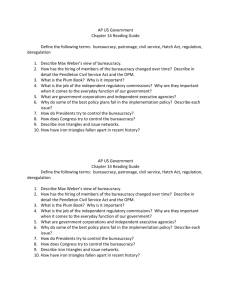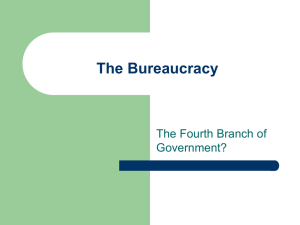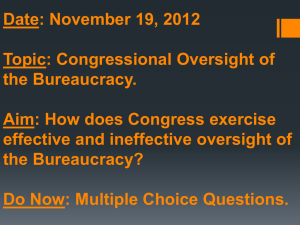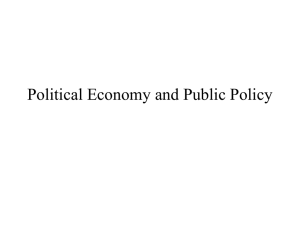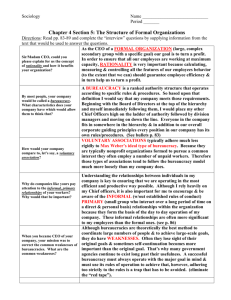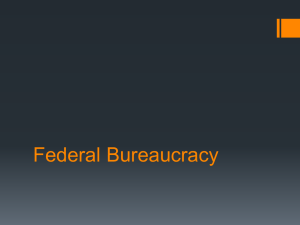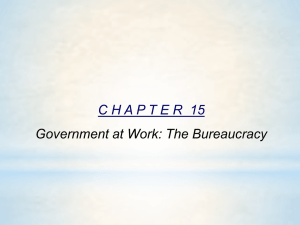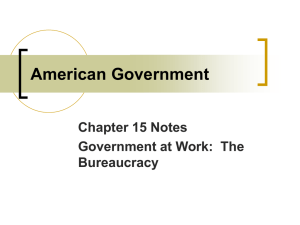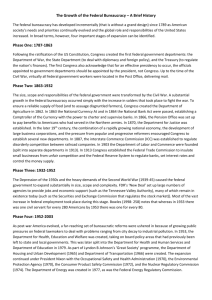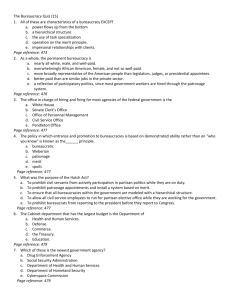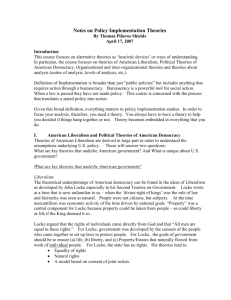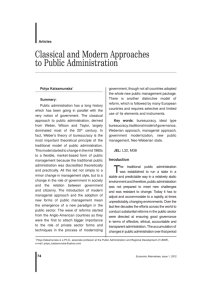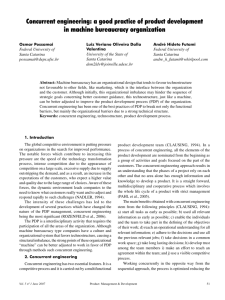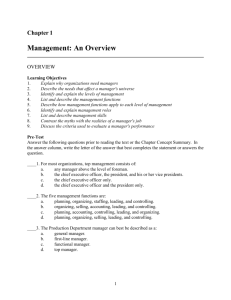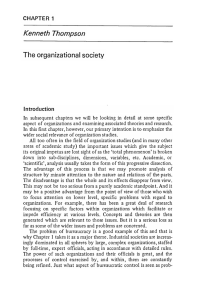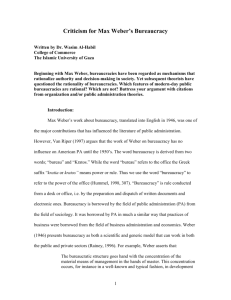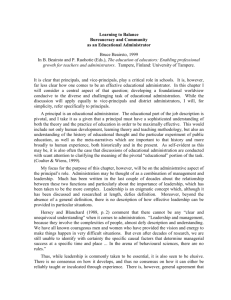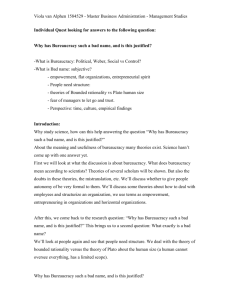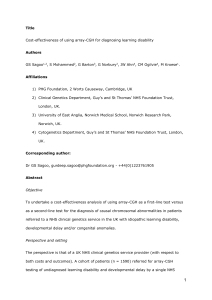447C DeVos – Alexandra Schmidt – Study Abroad Chapter 1
advertisement
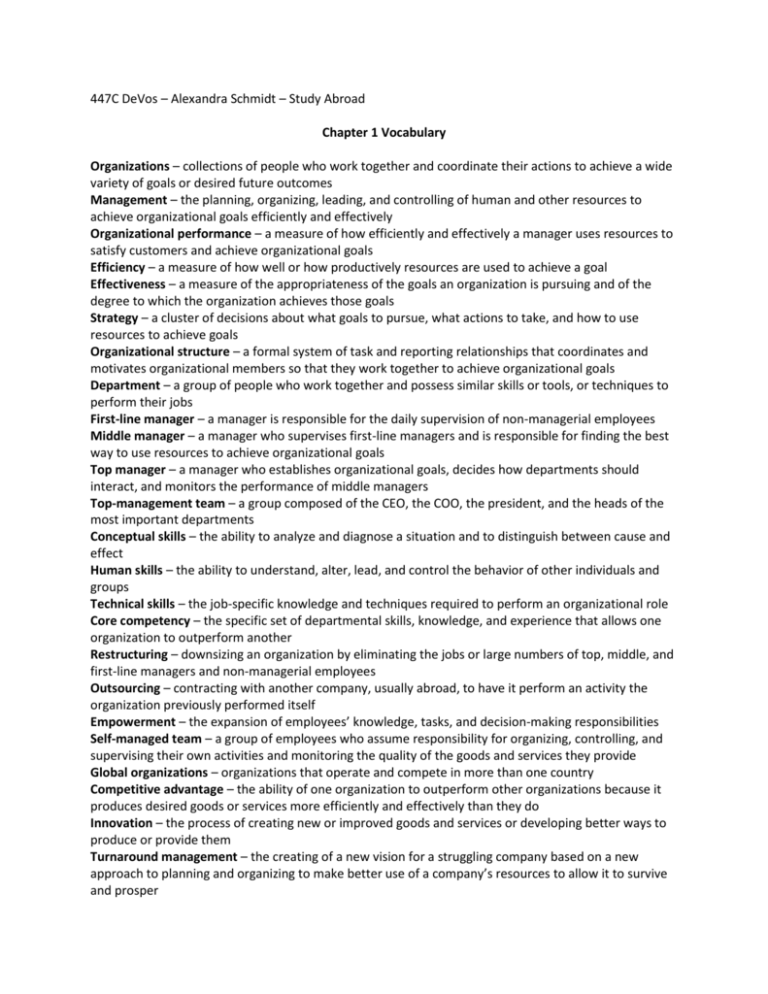
447C DeVos – Alexandra Schmidt – Study Abroad Chapter 1 Vocabulary Organizations – collections of people who work together and coordinate their actions to achieve a wide variety of goals or desired future outcomes Management – the planning, organizing, leading, and controlling of human and other resources to achieve organizational goals efficiently and effectively Organizational performance – a measure of how efficiently and effectively a manager uses resources to satisfy customers and achieve organizational goals Efficiency – a measure of how well or how productively resources are used to achieve a goal Effectiveness – a measure of the appropriateness of the goals an organization is pursuing and of the degree to which the organization achieves those goals Strategy – a cluster of decisions about what goals to pursue, what actions to take, and how to use resources to achieve goals Organizational structure – a formal system of task and reporting relationships that coordinates and motivates organizational members so that they work together to achieve organizational goals Department – a group of people who work together and possess similar skills or tools, or techniques to perform their jobs First-line manager – a manager is responsible for the daily supervision of non-managerial employees Middle manager – a manager who supervises first-line managers and is responsible for finding the best way to use resources to achieve organizational goals Top manager – a manager who establishes organizational goals, decides how departments should interact, and monitors the performance of middle managers Top-management team – a group composed of the CEO, the COO, the president, and the heads of the most important departments Conceptual skills – the ability to analyze and diagnose a situation and to distinguish between cause and effect Human skills – the ability to understand, alter, lead, and control the behavior of other individuals and groups Technical skills – the job-specific knowledge and techniques required to perform an organizational role Core competency – the specific set of departmental skills, knowledge, and experience that allows one organization to outperform another Restructuring – downsizing an organization by eliminating the jobs or large numbers of top, middle, and first-line managers and non-managerial employees Outsourcing – contracting with another company, usually abroad, to have it perform an activity the organization previously performed itself Empowerment – the expansion of employees’ knowledge, tasks, and decision-making responsibilities Self-managed team – a group of employees who assume responsibility for organizing, controlling, and supervising their own activities and monitoring the quality of the goods and services they provide Global organizations – organizations that operate and compete in more than one country Competitive advantage – the ability of one organization to outperform other organizations because it produces desired goods or services more efficiently and effectively than they do Innovation – the process of creating new or improved goods and services or developing better ways to produce or provide them Turnaround management – the creating of a new vision for a struggling company based on a new approach to planning and organizing to make better use of a company’s resources to allow it to survive and prosper Essential Managerial Tasks (p. 8) 1. Leading – articulating a clear vision and energizing and enabling organizational members so that they understand the part they play in achieving organizational goals 2. Organizing – structuring working relationships in a way that allows organizational members to work together to achieve organizational goals 3. Planning – identifying and selecting appropriate goals; one of the four principle tasks of management 4. Controlling – evaluating how well an organization is achieving its goals and taking action to maintain or improve performance Competitive Advantage (p. 23) 1. Efficiency (speed) 2. Quality 3. Innovation 4. Responsiveness to customers (flexibility) Mintzberg’s Typology (p. 13-14) 1. Decisional a. Entrepreneur – commit organizational resources to develop innovative goods and services; decide to expand internationally to obtain new customers for the organization’s products b. Disturbance handler – move quickly to take corrective action to deal with unexpected problems facing the organization from the external environment, such as a crisis like an oil spill, or from the internal environment, such as producing faulty goods or services c. Resource allocator – allocate organizational resources among different tasks and departments of the organization; set budgets and salaries of middle and first-line managers d. Negotiator – works with suppliers, distributors, and labor unions to reach agreements about the quality and price of input, technical, and human resources; work with other organizations to establish agreements to pool resources to work on joint projects 2. Interpersonal a. Figurehead – outline future organizational goals to employees at company meetings; open a new corporate headquarters building; state the organization’s ethical guidelines and the principles of behavior employees are to follow in their dealings with customers and suppliers b. Leader – provide an example of employees to follow; give direct commands and orders to subordinates; make decisions concerning the use of human and technical resources; mobilize employee support for specific organizational goals c. Liaison – coordinate the work of managers in different departments; establish alliances between different organization to share resources to produce new goods and services 3. Informational a. Monitor – evaluate the performance of managers in different tasks and take corrective action to improve their performance; watch for changes occurring in the external and internal environments that may affect the organization in the future. b. Disseminator – inform employees about changes taking place in the external and internal environment that will affect them and the organization; communicate to employees the organization’s vision and purpose c. Spokesperson – launch a national advertising campaign to promote new goods and services; give a speech to inform the local community about the organization’s future intentions Levels of Managers (p. 15) 1. CEO/COO 2. Top managers 3. Middle managers 4. First-line managers (supervisors) Chapter 2 Vocabulary Job specialization – the process by which a division of labor occurs as different workers specialize in different tasks over time Scientific management – the systematic study of relationships between people and tasks for the purpose of redesigning the work process to increase efficiency Principle 1: Study the way workers perform their tasks, gather all the informal job knowledge that workers possess, and experiment with way of improving how tasks are performed Principle 2: Codify the new methods of performing tasks into written rules and standard operating procedures Principle 3: Carefully select workers who possess skills and abilities that match the needs of the task, and train them to perform the task according to the established rules and procedures Principle 4: Establish a fair or acceptable level of performance for a task, and then develop a pay system that provides a reward for performance above the acceptable level Administrative management – the study of how to create an organizational structure and control system that lead to high efficiency and effectiveness Principle 1: In a bureaucracy, a manager’s formal authority derives from the position he or she holds in the organization Principle 2: In a bureaucracy, people should occupy positions because of their performance, not because of their social standing or personal contacts Principle 3: The extent of each position’s formal authority and task responsibilities, and its relationship to other positions in an organization, should be clearly specified Principle 4: Authority can be exercised effectively in an organization when positions are arranged hierarchically, so employees know whom to report to and who reports to them Principle 5: Managers must create a well-defined system of rules, standard operating procedures, and norms so that they can effectively control behavior within an organization Bureaucracy – a formal system of organization and administration designed to ensure efficiency and effectiveness Principle 1: In a bureaucracy, a manager’s formal authority derives from the position he or she holds in the organization Principle 2: In a bureaucracy, people should occupy positions because of their performance, not because of their social standing or personal contacts Principle 3: Principle 4: Principle 5: Authority – the power to hold people accountable for their actions and to make decisions concerning the use of organizational resources Rules – formal written instructions that specify actions to be taken under different circumstances to achieve specific goals Standard of Operating Procedures (SOPs) – specific sets of written instructions about how to perform a certain aspect of a task Norms – unwritten, informal codes of conduct that prescribe how people should act in particular situations and are considered important by most members of a group or organization Behavioral management Hawthorne effect Human relations movement Informal organization Organizational behavior Theory X – a set of negative assumptions about workers that lead to the conclusion that a manager’s task is to supervise workers closely and control their behavior Theory Y – a set of positive assumptions about workers that lead to the conclusion that a manager’s task is to create a work setting that encourages commitment to organizational goals and provides opportunities for workers to be imaginative and to exercise initiative and self-direction Management science theory Organizational environment Open system Closed system Entropy Synergy Contingency theory Mechanistic structure Organic structure The Evolution of Management (p. 41) 1890 Scientific Management theory (Taylor & Gilbreths) 1895 Administrative Management theory (Weber & Fayol) – Bureaucracy 1910 Behavioral Management theory (Follett) 1940 Management Science Theory o Quantitative management o Operations management o Total quality management (TQM) o Management information systems (MIS) 1950 Organizational Environment Theory Weber’s Principles of Bureaucracy (p. 49) A bureaucracy should have a: Clearly specified hierarchy of authority Selection and evaluation system that rewards employees fairly and equitably Clearly specified system of task and role relationships System of written rules and standard operating procedures that specify how employees should behave Principles of Management (p. 51) 1. Division of labor 2. Authority and responsibility 3. Unity of command 4. Line of authority 5. Centralization 6. Unity of direction 7. Equity 8. Order 9. Initiative 10. Discipline 11. Remuneration of personnel 12. Stability of tenure of personnel 13. Subordination of individual interests to the common interest 14. Espirit de Corps Closed system – functions on its own Open system – interacts with other systems; sales of outputs allow organization to obtain new supplies of inputs Input stage – organization obtains inputs from its environment o Raw materials o Money and capital o Human resources Conversion stage – organization transforms inputs and adds value to them o Machinery o Computers o Human skills Output stage – organization releases outputs to its environment o Goods o services

